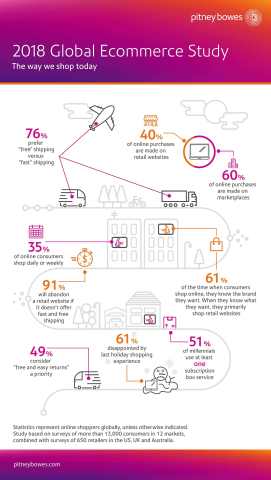<< Back
Pitney Bowes Global Ecommerce Study Finds We Are Shopping Online More Frequently and Frustrated More Often
61% of online shoppers disappointed by last holiday shopping experience
Frequency of online shopping up significantly in the US and
This press release features multimedia. View the full release here: https://www.businesswire.com/news/home/20181024005096/en/

2018 Pitney Bowes Ecommerce Study
Consumers pointed to post-purchase experiences, including items arriving late, expensive shipping, tracking inaccuracies, confusing returns policies, and lost or incorrect items as reasons for their dissatisfaction.
“More and more, consumers are telling us that the post-purchase
experience – what happens after the order – is every bit as important,
if not more, than the shopping experience that occurs before the order,”
said
Despite frustrations, consumers are shopping online more frequently
Nearly everyone is shopping online – 94% of consumers globally;
unchanged year-over-year. But, the frequency with which consumers shop
online is accelerating. Globally, 35% of online shoppers make an online
purchase at least weekly. In the US, 30% make an online purchase at
least weekly, up from just 19% a year ago. The
Snyder says the uptick in shopping frequency, while welcome news for retailers, is also contributing to the rise in consumer dissatisfaction. “Individual consumers are spending more time shopping online and waiting on products, creating a greater probability for a bad experience,” she said. “As volumes rise, retailers are struggling to keep up with the demand in terms of physical infrastructure and the technology to manage it effectively.”
Fast and free shipping are table stakes for online retailers
The study shows that consumers start to make judgements on the post-purchase experience even before placing their orders. In fact, 91% of online shoppers in the US said they will leave a retail web site if critical services like “fast and free shipping” are not available. At the same time, consumers are becoming more demanding in their expectations for “fast and free.” Only 47% consider 2-day free shipping “fast.”
“If there is one finding for retailers to pay attention to, it’s this one: fast and free shipping is a must,” said Snyder. “Retailers invest millions of dollars in marketing to drive consumers to their ecommerce sites, but all of that expense and effort is for naught if they don’t also invest in attractive fast and free shipping offers that meet consumer expectations.”
Consumers still rank “free shipping” as more important than “fast shipping.” Globally, 76% of consumers prefer “free” over “fast.” In the US, however, the trend is starting to reverse, with 79% preferring “free” over “fast,” down from 86% the year prior. This reversal is mostly driven by millennials, with 35% willing to pay for fast shipping, up from 20% the year prior.
In the US, online shoppers list free shipping (80%) and fast shipping
(66%) as the two most important criteria in determining where to shop
online. Two-thirds of online shoppers in the US think it is acceptable
to have a minimum purchase requirement of
A bad post-purchase experience can cost retailers multiple customers
According to the study, 90% of online shoppers in the US will take an action that can hurt a retailer’s brand in response to a bad post-purchase experience. Their reactions range from sharing their frustrations on social media to never purchasing from the offending site again. Among millennials, 30% will go public about their poor experience, complaining in an online review or social media post, potentially affecting the buying decisions of their entire social networks.
The importance of the post-purchase experience voiced loud and clear by consumers was further validated by the results of retailer surveys. Successful high-growth retailers (25% or greater YoY revenue growth) place a greater emphasis on the post-purchase consumer experience than their slower growth competitors. This includes providing services like free returns and day-definite guaranteed delivery. 54% of high-growth retailers offer 2-3 day free shipping, while 60% of low-growth retailers (10% or less YoY revenue growth) offer 4-7 day free shipping. High-growth retailers also tend to meet or exceed consumer demands for accurate, real-time tracking, free and fast shipping, easy returns with preprinted labels, prompt refunds and even attractive branded packaging.
One trend that may be influencing expectations around quality of packaging is the growth of subscription box services. 27% of online shoppers are subscribed to at least one such service, including 51% of millennials and 47% of households with children.
“Successful high-growth retailers and brands not only exceed their customers’ expectations on the post-purchase experience, but they leverage every consumer touchpoint to build brand awareness, further strengthening customer loyalty,” said Snyder.
In the battleground for consumer attention, the study found that marketplaces continue to soak up 60% of online purchases, but it also found opportunity for retailers who invest in their brand and delight consumers throughout the shopping and post-purchase experience. 61% of online shopping occurs when the consumer knows specifically what brand they’re looking to buy. In these cases, more than half (54%) prefer to buy from a retailer website over an online marketplace. This presents an opportunity for brands and retailers to build customer loyalty and trust by repeatedly delivering exceptional post-purchase experiences.
The same rules apply for cross-border shopping
The cross-border ecommerce market continues to mature. For the first
time, fewer consumers said they were shopping cross-border, dropping
from 70% in 2017 to 64% in 2018. The US,
Consistent with the results of the study, frustrations with shopping cross-border can be attributed primarily to shipping that is too slow, or too expensive. Other frustrations include the inconvenience of returning unwanted items and poor customer service.
The 2018 Pitney Bowes Global Ecommerce Study is based on surveys of more
than 13,000 consumers in 12 markets, combined with surveys of 650
retailers in the US,
For more information on the study including an interactive map and infographic, please visit The 2018 Pitney Bowes Global Ecommerce Study.
About
View source version on businesswire.com: https://www.businesswire.com/news/home/20181024005096/en/
Source:
Pitney Bowes
Brett Cody
W 203 351 6079
M 203 218 1187
Brett.cody@pb.com
